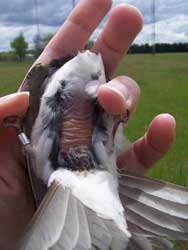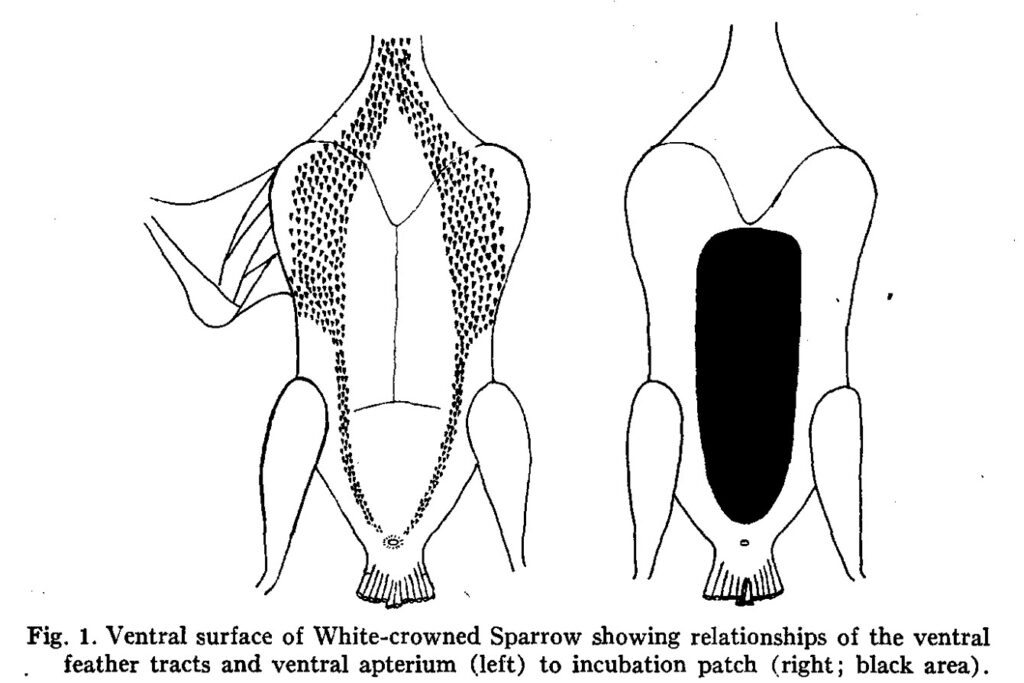Answer: A brood patch is like an egg/nestling warming pad.

“Incubating” or “brooding” is when a bird sites on its eggs (or nestlings) to keep them warm. If eggs are not kept within a certain temperature range for a certain period of time, they will not hatch.
A brood patch is a bare, flaccid patch of skin where downy feathers either fall out (through a special molt), or are actively plucked out (e.g., parrots and wood ducks pluck the feathers, using them to line the nest.)
This happens towards the end of the egg-laying period, just before incubation begins (maybe four to six days before the first egg?) Feathers provide insulation, but they are poor conductors of heat.
In most songbirds, woodpeckers and owls, there is a single brood patch in the middle of the bird’s belly region, but depending on the species, they differ in location, number and size.

The skin that makes up the brood patch thickens, and becomes engorged with blood vessels that increase in size and number during breeding season. The patch works like a hot water bottle to transfer heat from the parent’s body to the eggs. As the parent settles onto the nest, they may fluff the remaining feathers out, and wiggle around from side to side in order to achieve good skin contact with the eggshells.
The feathers do regrow. The patch is usually gone by the time the babies fledge (leave the nest), although it may stay un-feathered until the fall molt. The feathers regrow sooner after hatching in precocial birds (babies born covered with down) than for those that have altricial (born mostly naked) birds. That is probably because the altricial young don’t have insulating down, so the adult may need to continue to brood them until they are old enough to regulate their own body temperature.
Note that some birds are “steady incubators” and others are “intermittent incubators.” In the intermittent incubators, when the brood patch touches the cooled egg, the birds heart rate increases and the veins delivering blood to the patch dilate. When the egg is warmed to the “exit temperature,” the parent may leave temporarily – after all, they do need to eat, poop and drink on occasion. In species like bluebirds, the male will come to the nest to deliver food to the incubating female, enabling her to stay longer on the eggs.
Who Broods?
Usually the female does the brooding. In some species, both sexes get into the act. Both male and female woodpeckers develop a brood patch. Acorn Woodpeckers form family groups where multiple birds get involved in egg and nestling care. In other species, the male may not have one, but may still “sit” on the eggs to slow down heat or water loss from the egg when the female is away.
MORE INFORMATION & REFERENCES:
- The Amazing Egg
- How many broods does a bluebird have?
- Heat & Cold: Beat It
- On the Thermal Capacity of a Bird’s Egg Warmed by a Brood Patch, J. Scott Turner, Physiological Zoology, 1997.
- The Incubation Patch of Passerine Birds, Robert E. Bailey, The Condo, May-June 1952, Vol.54, Number 3.
- The nesting cycle follows this pattern: courtship & territory formation (some species don’t establish territories), nest building (and copulation during this time), egg laying (usually one a day, or one every other day), incubation (of the eggs), brooding (of the nestlings), and fledging (leaving the nest.) Depending on the species, after fledging the parent(s) may continue to feed their young for a period of time.
- Formation of a brood patch may be controlled by hormones such as estrogen and prolactin.
